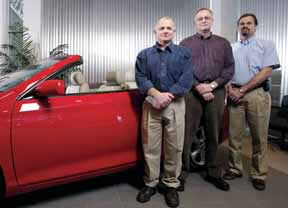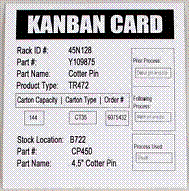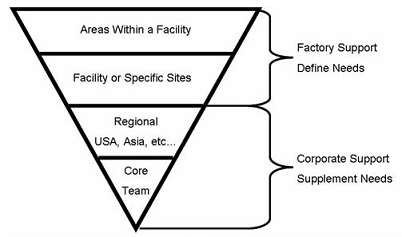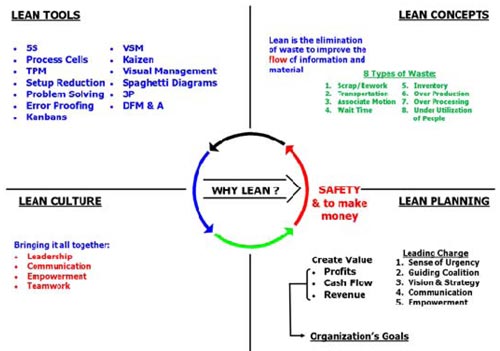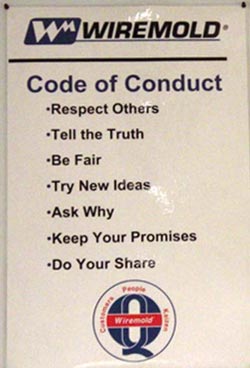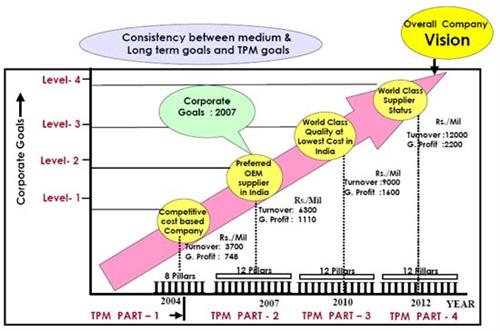Just the FactsPlant: Whirlpool Corporation in Findlay, Ohio |
Whirlpool Corporation runs in familiar circles.
Mechanically, the inner workings of this company’s dishwashers and washing machines twirl around water and detergent to clean up your cooking and clothing messes.
Financially, it’s a $13 billion-a-year firm that for decades has held a prestigious spot on the Fortune 500 list (No. 79 in the 2005 rankings).
Societally, it’s one of the world’s most recognizable brands.
And socially, it holds upper-hand status on its well-known consumer appliance cronies – General Electric, Maytag and Frigidaire.
Familiarity is one of Whirlpool’s biggest assets, but it’s also a major challenge.
“The marketplace is changing and it’s being led by companies that we do not know nearly as much about,” says Larry Dunfee, the manager of Consumer-Centered Manufacturing at Whirlpool’s site in Findlay, Ohio, the largest dishwasher manufacturing plant in the world.
That’s not spin. If you haven’t heard of companies such as Shian Jing, Wenling Changtian and Naiko Asia – kitchen appliance manufacturers from China and Taiwan – you will soon.
“We are used to competing against North American manufacturers in dishwashers. We know them and they know us,” Dunfee says. “We are all in the high-labor-cost North American market. We can all make improvements, but nobody has a strong leg up on anybody else. But now, we’re starting to see other companies coming from low-wage countries. They are starting to market their products in North America at a competitive price point. We see the possibilities of them using the leverage they have from a labor cost standpoint. That will put us in a difficult position to compete unless we do things differently.”
Whirlpool’s response is revolution. While still entrenched as the No. 1 player in the sector, the company has churned the waters and sought ways to:
maximize its mechanical assets; and,
maximize the contributions of its workforce.
Revolution has resulted in increased uptime, productivity and quality. This postively impacts revenue, profitability and share price.

The Pieces Fit Together
The 2,000 employees at Whirlpool’s 1 million-square-foot facility in Findlay, Ohio, are no stranger to the concepts of machine reliability and empowerment.
Maintenance management, in conjunction with production and operations leaders, introduced Total Productive Manufacturing (TPM) and Reliability-Centered Maintenance (RCM) to the plant in the mid- and late-1990s. And early on, plant-floor employees played key roles in implementing improvement projects.
The difference, comparing 2005 with 1995, is cohesiveness. Whirlpool improvement tools now fit together instead of, in some cases, running parallel to one another. And, maintenance and production workers more uniformally buy into the vision that “we are all responsible for the equipment.”
TPM + RCM = Results
TPM (also known as Total Productive Maintenance) is a team-based approach to maintaining the condition of equipment. Its key components are operator ownership of equipment, continuous identification and implementation of improvements, and the development of planned maintenance.
Whirlpool places approximately 10 area operators and maintenance personnel across the various shifts on a TPM team. In TPM’s formative years at Whirlpool, a team was led by a process engineer or area supervisor. After receiving instruction on the principles of TPM and overall equipment effectiveness (OEE is a metric that tracks sources of operating loss, including equipment availability, performance and quality), each team began to identify opportunities in its functional area. The team then sought and implemented solutions to eliminate identified sources of loss.
Today, hourly workers share leadership roles on each of the plant’s 32 teams. In another departure from the past, RCM has become an important part of the TPM curriculum. All teams now get early exposure to an RCM analysis.

Electrical engineer Tom Jones (right)
works closely with production workers.
RCM links a structured thought process to the knowledge of a cross-functional team. Over a three- to five-day period, the goal is to develop a complete maintenance strategy for a process or piece of equipment.
During a recent RCM event, for example, senior reliability engineer Richard Word served as the facilitator of a 12-member cross-functional group that included two operators, two electricians, one operations supervisor, one operations engineer, one plastic molding technician, one quality process analyst, one millwright, one maintenance engineer, one maintenance supervisor and one supplier representative.
This group painstakingly analyzed the components of a vertical plastic press (hydraulic heat exchanger, flow control valve, light curtain, etc.), pinpointed all of the failure modes and effects, and implemented a maintenance strategy for each component to make the overall press more robust.
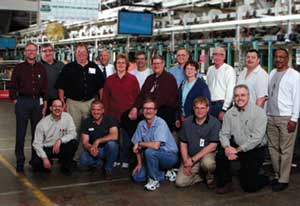
Senior reliability engineer Richard Word (seated in middle)
is flanked by the members of his recent RCM team.
All total, they followed a 14-step analytical process:
- Review the equipment’s operational history.
- Detail the parameters for probability of failure.
- Detail the parameters for consequence of failure.
- List the main functions.
- List the sub-functions.
- List the failure modes.
- List the failure effects.
- List the downtime.
- List the consequence.
- Navigate a decision tree.
- Determine the proper maintenance task.
- Determine the need for stocking a spare part.
- Review the completeness of the analysis for the time scheduled.
- Do a reality check.
“RCM is a good kickoff to the TPM team,” says maintenance and tooling manager John Siefker. “They really review the process and the equipment. It is a learning exercise of how it actually works. When you have an operator alongside a maintenance technician and an engineer, they start talking together about different components and what they do. Everyone provides their real-world perspective. Suddenly, light bulbs go on. This gives everyone a better understanding of the total process and what the end result is.”
To date, more than 20 percent of workers at the Findlay plant have participated in an RCM event.
Up until a few years ago, RCM analyses functioned mostly independent from other improvement projects. In large part, they now exist to provide perspective and work tasks for TPM teams.
Most of the RCM implementation involves reviewing and transferring a detailed maintenance task into the preventive maintenance (PM) system. PM tasks, which used to be highly generic in nature, now are information-heavy. Each task includes equipment status (running, anytime or down), an action verb (check, measure, inspect), the specific component (main motor), the specific condition (quantifiable whenever possible) and a reference to a condition-monitoring standard (if available or required).
Responsibility for tackling these PM tasks is generally split 50/50 between operators and maintenance technicians.
“TPM and RCM are not separate entities anymore,” says Word. “They always complemented one another, but we have gotten to the point where they come together and cross paths.”

Plant leaders, including facilities engineering
manager Randy Statzer (left), Consumer-Centered
Manufacturing manager Larry Dunfee and TPM
facilitator Jim Dray, help oversee the progress
of the reliability initiatives.
‘We Are All Responsible’
Shifting many of the maintenance functions to operators has allowed operators to take more “ownership” of the equipment.
“Operators originally thought their job was making components or assembling dishwashers,” says TPM facilitator Jim Dray. “That’s changed. We stress that you are responsible for the health and productivity of the equipment. It’s your job. It’s everyone’s job at this plant.”
Ownership means operators perform PM tasks such as cleaning and lubricating the machinery, changing belts and hoses, and monitoring heat strips and gauge tape. It also means that they handle many predictive maintenance tasks.
“We’ve given out some handheld infrared guns. We also have ultrasound equipment that our equipment setup operators can use,” says Dray.
All this allows maintenance technicians to focus more on activities that actually prevent mechanical failures.
“Prevention is at the top of our list now,” says electrical engineer Tom Jones. “It’s better to prevent failure than predict it.”
As an example, representatives from maintenance and engineering work with equipment suppliers and supply them with ideas, feedback and the performance history of similar equipment currently in use. The end result is equipment that is more robust and more reliable before it even is installed on the plant floor at Whirlpool.
That sharing relationship continues after the installation. For example, a representative from Battenfeld, a manufacturer of injection molding machines, served on the recent RCM project.
“We’re still exploring ways to reach out and involve our supply base,” says Dunfee. “This is an area of opportunity.”
By focusing on prevention as opposed to settling for detection, Word says the plant has been able to surpass the 90 percent mark in uptime. Also, unplanned maintenance activities accounted for just 13.4 percent of documented work orders during a recent 30-day period.
Stepping Up to The Plate
Failure prevention and unified equipment ownership are also evident in the plant’s push to develop the problem-solving skills of its workers. This is further proof of the integrated nature of Whirlpool’s improvement tools.
TPM team members, the same ones who go through an RCM analysis, receive training on additional “lean manufacturing” concepts such as Continuous Improvement. The CI process attacks areas of opportunity with a formal seven-step problem-solving methodology.
The steps include:
State the initial (general, non-specific) problem.
Clarify the problem. (What’s the specific defect? What is standard vs. actual? What is the target for the specific problem?)
Pinpoint current processes that contribute to the problem. (What specific action or actions caused the non-standard condition?)
Identify the root cause of the problem. (The real cause is often hidden behind more obvious symptoms.)
Suggest countermeasures to ensure the problem doesn’t happen again. (These are ideas to attack the root cause.)
Create plans to implement the countermeasures. (Get the formal battle plan in order to attack the root cause.)
Implement countermeasures and perform a follow-up. (Were the countermeasures effective? If yes, continue to monitor and ensure the solution sticks. If no, backtrack and develop new countermeasures.)
“This is a disciplined approach to problem-solving as opposed to shooting from the hip,” says Jones, explaining that traditional methods may or may not address the root cause or may focus on the “trivial many” issues as opposed to the “meaningful few.”
In a recent TPM Steering Committee meeting, teams presented case studies on how they solved problems related to non-fitting console seals, inconsistent performance on screwdriving assembly guns and impaired visibility of cycle indicator lights.
These problem-solving exercises are required for TPM teams to obtain and retain a Whirlpool certification status (see sidebar for certification guidelines).
On top of CI, the plant also incorporates lean thinking in a practice called “gemba” walks. (Gemba is a Japanese term that roughly translates to “the place where value is added.”) Here, maintenance and production leaders, hourly workers and even division vice president John Haywood stroll through a particular area of the facility and identify areas of waste, non-value activities, and ergonomic or safety issues.
Waste elimination is a major push. As one sign in the plant states: “If it doesn’t add value, it’s waste! What are you doing to reduce waste? Are you, as a customer, willing to pay for overproduction, inventory, long changeovers, searching for tools/parts, unplanned downtime, rework/scrap, unnecessary long distances or keeping ideas to yourself?”
One of the metrics used by the plant to record levels of waste is critical process yield. CPY accounts for many sources of loss. It starts with a baseline of maximum theoretical production rate and then all the sources of loss are calculated and deducted to give the percent of theoretical maximum capacity. At a high level, the sources of loss include availability, performance and quality. As the CPY figure increases, so does productivity.
Prior to the maturation and cohesion of Whirlpool’s improvement tools, assets at the Findlay plant produced at 60 to 70 percent of their capability. Benchmarks indicated that 85 to 90 percent was possible. In recent years, the plant CPY average rose to 79 percent in 2003, 84 percent in 2004 and 85 percent for the first three months of 2005.
“If we are making the right decisions and doing the right maintenance, it all comes together and we have some assurances,” says Jones. “All of this puts less stress on me and everyone else.”
Revolution’s Evolution
This Findlay, Ohio, plant is a shining example of what can happen when energized people and powerful tools come together to drive improvement.
Whirlpool has seen the benefits. It knows that this model allows it to better address present and future challenges and challengers. Therefore, it’s working to spread the news. Word is visiting sister sites in North America this year to teach strategies for RCM implementation. Dray did the same for TPM in years prior.
Back in Findlay, though, nobody is resting on laurels.
“When your ultimate goal is continuous improvement, you never get there,” says Dray. “It’s a never-ending process. That’s difficult for some people. They say, ‘Give me a goal. I’ll achieve it. I’m done. What’s next?’ With this, there is no end.”
It just goes round and round ... like a circle.
TPM Certification Guidelines
|


